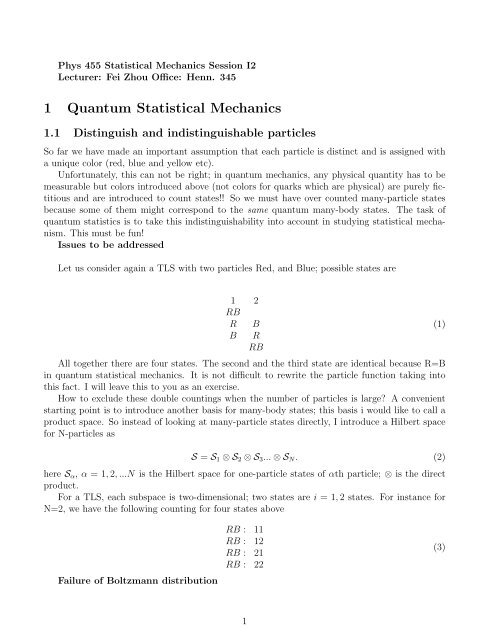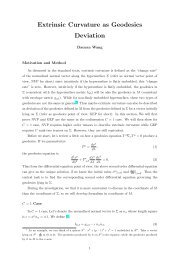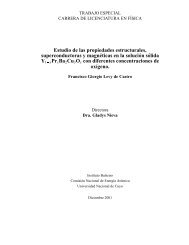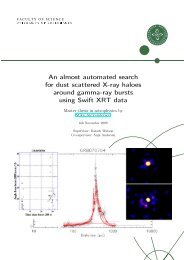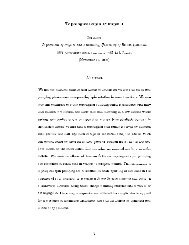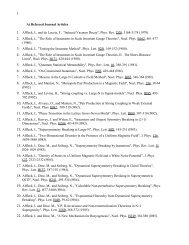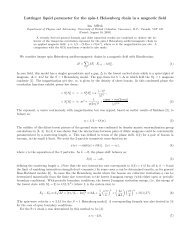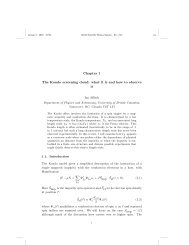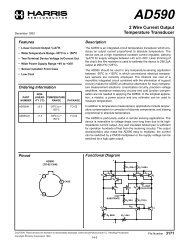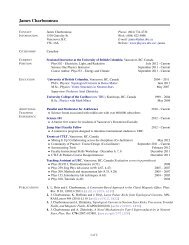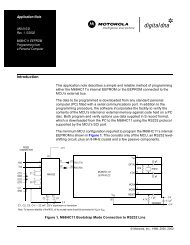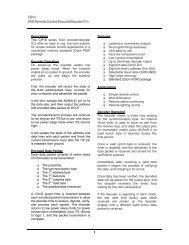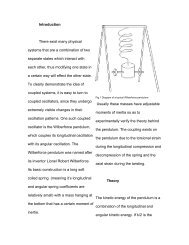1 Quantum Statistical Mechanics - UBC Physics & Astronomy
1 Quantum Statistical Mechanics - UBC Physics & Astronomy
1 Quantum Statistical Mechanics - UBC Physics & Astronomy
You also want an ePaper? Increase the reach of your titles
YUMPU automatically turns print PDFs into web optimized ePapers that Google loves.
Phys 455 <strong>Statistical</strong> <strong>Mechanics</strong> Session I2<br />
Lecturer: Fei Zhou Office: Henn. 345<br />
1 <strong>Quantum</strong> <strong>Statistical</strong> <strong>Mechanics</strong><br />
1.1 Distinguish and indistinguishable particles<br />
So far we have made an important assumption that each particle is distinct and is assigned with<br />
a unique color (red, blue and yellow etc).<br />
Unfortunately, this can not be right; in quantum mechanics, any physical quantity has to be<br />
measurable but colors introduced above (not colors for quarks which are physical) are purely fictitious<br />
and are introduced to count states!! So we must have over counted many-particle states<br />
because some of them might correspond to the same quantum many-body states. The task of<br />
quantum statistics is to take this indistinguishability into account in studying statistical mechanism.<br />
This must be fun!<br />
Issues to be addressed<br />
Let us consider again a TLS with two particles Red, and Blue; possible states are<br />
1 2<br />
RB<br />
R B<br />
B R<br />
RB<br />
All together there are four states. The second and the third state are identical because R=B<br />
in quantum statistical mechanics. It is not difficult to rewrite the particle function taking into<br />
this fact. I will leave this to you as an exercise.<br />
How to exclude these double countings when the number of particles is large? A convenient<br />
starting point is to introduce another basis for many-body states; this basis i would like to call a<br />
product space. So instead of looking at many-particle states directly, I introduce a Hilbert space<br />
for N-particles as<br />
S = S 1 ⊗ S 2 ⊗ S 3 ... ⊗ S N . (2)<br />
here S α , α = 1, 2, ...N is the Hilbert space for one-particle states of αth particle; ⊗ is the direct<br />
product.<br />
For a TLS, each subspace is two-dimensional; two states are i = 1, 2 states. For instance for<br />
N=2, we have the following counting for four states above<br />
(1)<br />
Failure of Boltzmann distribution<br />
RB : 11<br />
RB : 12<br />
RB : 21<br />
RB : 22<br />
(3)<br />
1
Once we use such a product space, we reproduce the partition function discussed in the previous<br />
session in a different form<br />
Z = ∑ ∑<br />
.... ∑ exp(−βɛ i1 ) × exp(−βɛ i2 ).... exp(−βɛ iα )... × exp(−βɛ iN ). (4)<br />
i1 i2 iN<br />
Again α = 1, 2, ...N labels the color of particles and i labels the one-particle states running from<br />
1 to n, n being the dimension of the one-particle Hilbert space. It reflects the democracy of<br />
statistical mechanics.<br />
This leads to the result we mentioned before<br />
Z = Z 1 × Z 2 ... × Z α .... × Z N . (5)<br />
So far we simply rewrite the known result of Boltzmann distribution.<br />
If the dimension of one-particle Hilbert space n is much larger than the number of particles<br />
involved for the study, Can one claim that the probability to find a one particle-state occupied by<br />
two colored particles is negligible?<br />
Exercise 1 Put forward arguments for or against this claim.<br />
If under certain conditions that particles are unlikely to occupy the same state, the partition<br />
function for indistinguishable particles is simply<br />
Z = 1 N! Z 1 × Z 2 ... × Z α .... × Z N . (6)<br />
Exercise 2 Show the prefactor N!.<br />
In this limit,Botzmann distribution is an excellent approximation to reality. But what about<br />
the opposite limit ?? How to deal with that limit?<br />
Further demonstration<br />
The previous claim is actually not correct. What one has to look at is the occupation of<br />
particles at a given level.<br />
n i = N exp( −ɛ i<br />
kT ) 1 Z 1<br />
. (7)<br />
As an estimate one can show that this number if much less than one if<br />
N ≪ D(kT ), (8)<br />
where D(ɛ) is the number of one particle states at energies less than ɛ.<br />
Take a box of particles. It is easily to show that the constraint indicates that<br />
λ(T ) =<br />
¯h<br />
√<br />
2mkT<br />
≪ ( V N )1/d . (9)<br />
d is the dimension of space. This means that the Boltzmann distribution is correct description of<br />
the reality if the temperature of particles is sufficiently high. It breaks down at low temperatures,<br />
which makes low temperature phenomena fascinating. Qualitatively, this is the limit where the<br />
wave packet of particles of energy kT (the size of which is approximately λ) starts to overlap in<br />
space.<br />
2
1.2 Fermions and Bosons; Pauli exclusion principle<br />
Since particles are indistinguishable, we have to decide the rule of games when two particles are<br />
in the same one-particle state ɛ 1 . 1 Most natural choices one can make at this level are<br />
Class A: No two particles can occupy the same state. (Pauli exclusion principle)<br />
Class B: Two or more particles can occupy the same state.<br />
Particles belonging to these two classes correspond to fermions and bosons respectively. We<br />
will explore the consequencies of these two constraints on indistinguishable particles.<br />
1.3 Fermi-Dirac statistics<br />
A many-body state is represented by a series of bits or coordinates in the Fock space<br />
And the Fock space is defined as a space<br />
{N 1 , N 2 , ...N M }; N i = 0, 1. (10)<br />
F = F 1 ⊗ ... ⊗ F M (11)<br />
and F i is a space with two states (with different number of particles)<br />
N i = 0, no particle occupying one-particle state i;<br />
N i = 1, one particle occuping one-particle state i. (12)<br />
Z =<br />
∑<br />
∑<br />
N 1 =0,1 N 2 =0,1<br />
...<br />
∑<br />
N n=0,1<br />
ɛ 1 − µ<br />
Ω(N 1 , N 2 , ...N n ) exp(−N 1<br />
kT<br />
) × ... × exp(−N ɛ n − µ<br />
n ). (13)<br />
kT<br />
For indistinguishable particles, a many-body state is completely given by its coordinate in the<br />
Fock space and Ω = 1.<br />
Given this information one easily shows that<br />
Z = Z 1 × ... × Z M ; Z i = 1 + exp(− ɛ i − µ<br />
). (14)<br />
kT<br />
One can then show that the number of fermions at level i is<br />
1<br />
f F D =<br />
1 + exp( ɛ (15)<br />
i−µ<br />
).<br />
kT<br />
This distribution function varies from 0 to 1.<br />
Exercise 1 Show the Fermi-Dirac distribution function.<br />
1 There might be more sophisticated classifications; furthermore there are so-call anyonic statistics differing from<br />
the ones I am going to discuss. But I will not consider these possibilities because these are subjects under debate.<br />
3
1.4 Bose-Einstein statistics<br />
We can again write down the partition function for bosons<br />
Z =<br />
∞∑<br />
∞∑<br />
N 1 =0,... N 2 =0,...<br />
...<br />
∞∑<br />
N M =0,...<br />
ɛ 1 − µ<br />
Ω(N 1 , N 2 , ...N n ) exp(−N 1<br />
kT<br />
) × ... × exp(−N M<br />
Note that each summation is carried over all integers.<br />
This partition function can be calculated directly and I find<br />
ɛ M − µ<br />
). (16)<br />
kT<br />
Z = Z 1 × ... × Z n ; Z i =<br />
The average population of bosons at level i is<br />
1<br />
1 − exp(− ɛ (17)<br />
i−µ<br />
).<br />
kT<br />
f BE =<br />
1<br />
exp( ɛ i−µ<br />
kT<br />
) − 1.<br />
(18)<br />
It varies from zero to infinity. See nice discussions in the textbook, page 262-270. Especially figure<br />
7.7.<br />
Exercise 2 Derive f BE .<br />
4


